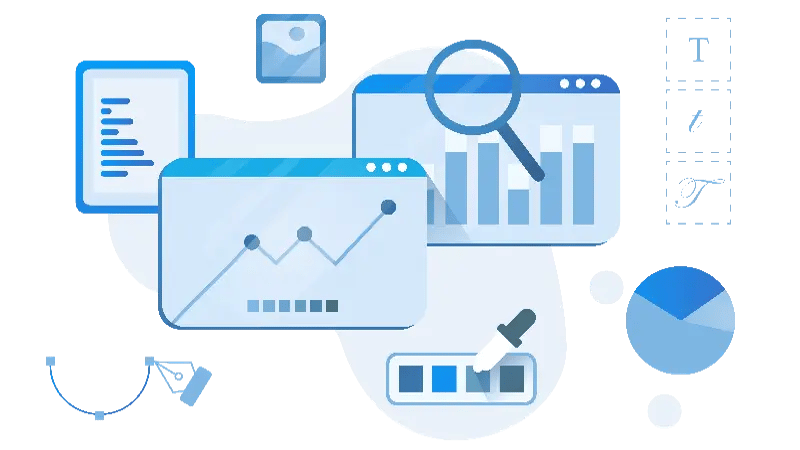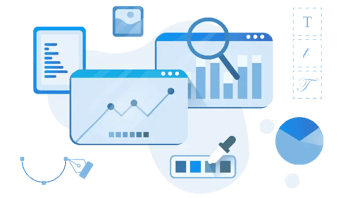Designing Websites with Data: Iterative Development and A/B Testing
Ever notice how some websites seem to intuitively understand your needs, guiding you effortlessly towards your goals? What's their secret? It's rarely about fleeting trends or purely subjective design choices.
The foundation of truly impactful web design lies in a dynamic and intelligent approach that prioritizes real user behavior and measurable outcomes. Building high-performing websites in today's digital landscape demands a commitment to continuous improvement, driven by tangible evidence.
This evidence comes from a data-driven and iterative methodology. Instead of static launches, imagine a cycle of continuous refinement, where every design and development decision is informed by how users actually interact with your site. This isn't about guessing what works; it's about knowing. This constant cycle of building, testing, and learning, particularly through techniques like A/B testing, allows for ongoing optimization.
The ultimate aim? To create digital experiences that not only meet but exceed user expectations and adapt seamlessly to evolving business and customer needs–a core tenet of growth-driven design (GDD). So, how does this iterative process actually unfold? Let's delve into the essential steps.
The Iterative Development Cycle
So, what exactly does it mean to embrace an iterative development cycle? Simply put, it's a method of building and refining your website through a series of focused cycles, rather than one monolithic launch. Think of it as a continuous journey of improvement, where each step builds upon the learnings of the last. These cycles are not arbitrary; they follow a structured approach encompassing planning, designing and developing, rigorous testing, thorough evaluation through data analysis, and finally, optimization based on those insights.
Let's break down these essential stages:
-
Planning: This isn't just about brainstorming ideas; it's about defining crystal-clear goals and formulating specific hypotheses grounded in initial data or a deep understanding of your target audience. For instance, instead of setting a nebulous objective like "improve user experience," a data-informed goal would be: "Decrease the cart abandonment rate on the checkout page by 10% within the next six weeks." This clarity allows for focused effort and measurable results.
-
Design and development: Here, you translate the planned changes into tangible website elements. This might involve tweaking the layout of a landing page, rewriting call-to-action buttons, or even implementing entirely new features. The key is that these changes are directly tied to the hypotheses developed in the planning stage. It's not about making wholesale changes but rather focused adjustments aimed at addressing specific areas for improvement.
-
Testing: When it comes to website optimization, A/B testing often takes center stage. At its core, A/B testing involves creating two or more versions of a specific webpage element and showing them to different segments of your website visitors simultaneously. By comparing how each version performs against key metrics, you can definitively determine which one resonates better with your audience.
-
Data analysis: This is where you rigorously examine the results of your tests and other website performance metrics to extract meaningful insights. What do the numbers tell you? Are your changes driving the desired outcomes? Key metrics to consider include conversion rates, bounce rates, time on page, and click-through rates.
-
Optimization: This involves implementing the winning variations identified through testing and using the learnings to inform future iterations. If headline A significantly outperformed headline B, you would implement headline A. Moreover, the data gathered provides valuable clues for your next set of hypotheses and tests.
It's important to remember that this isn't a one-time event; it's a continuous loop. The insights gained from one cycle directly feed into the planning stage of the next. You are constantly learning, adapting, and refining your website based on real user behavior. Think of it like refining a recipe. You might try a version (the initial design), taste it (observe user behavior), identify areas for improvement (analyze the data), adjust the ingredients (design and develop changes), and taste it again (run another test). This ongoing process of tasting and adjusting ultimately leads to a much more successful and satisfying final product–a truly high-performing website.
Data Analysis in Web Optimization
When it comes to truly effective optimization, the power of data analysis cannot be overstated. In web design, relying on subjective opinions or gut feelings is like navigating a maze blindfolded. Concrete data provides the necessary illumination, revealing user behaviors, identifying areas of friction, and ultimately guiding you toward impactful improvements for your website. It transforms website optimization from a guessing game into a strategic, evidence-based process.
So, what key data points should you be tracking? Understanding user behavior, conversion metrics, and technical performance is paramount. Tools like Google Analytics and Adobe Analytics offer invaluable insights into how visitors interact with your site.
-
User behavior:
-
Page views
-
Time on page
-
Bounce rate
-
Exit rate
-
User flow/navigation paths
-
Heatmaps and clickmaps
-
-
Conversion metrics:
-
Conversion rate (overall and per goal)
-
Goal completions (e.g., form submissions, purchases, downloads)
-
Cost per acquisition (CPA)
-
Return on ad spend (ROAS)
-
Customer lifetime value (CLTV)
-
-
Technical performance:
-
Page load time
-
Mobile responsiveness
-
Core web vitals
-
Accessibility metrics
-
The true power of data analysis lies in its ability to move beyond simply collecting numbers to turning data into actionable insights. This involves interpreting the patterns and trends you observe and translating them into testable hypotheses. For example, if your analytics reveal a high exit rate on your checkout page, a logical hypothesis could be that a complex or lengthy form is causing friction.
This insight then leads to a specific test: simplifying the form fields to see if it improves conversion rates. By following this process, you transform raw data into targeted strategies for website improvement, paving the way for continuous optimization and ultimately, the creation of truly high-performing websites.
Integrating Testing for Continuous Improvement
The insights gleaned from data analysis only become truly valuable when they fuel a culture of continuous improvement, and at the heart of this culture lies systematic testing. While A/B testing, comparing two variations of a single element, is a cornerstone of this process, it's worth noting that other methodologies exist for more intricate scenarios.
For example, multivariate testing allows you to test multiple variations of several elements simultaneously to see which combination yields the best results. However, for most optimization efforts, A/B testing provides a powerful and straightforward approach.
So, what aspects of your website are ripe for experimentation?
-
Consider testing different headlines and subheadings to see which ones capture attention and encourage clicks.
-
Experiment with your call-to-action button copy, placement, and design to maximize conversions.
-
The impact of images and videos can also be significant; try different visuals to see how they affect engagement.
-
For lead generation, the form length and fields can be critical–shorter forms might increase submissions but yield less qualified leads.
-
Don't overlook the impact of page layouts and navigation; even small tweaks can significantly improve user experience.
-
Finally, for e-commerce sites, testing different pricing and promotions is a constant area for optimization.
To ensure your testing efforts yield meaningful results, it's crucial to set them up effectively. A fundamental principle is to test one variable at a time. This allows you to isolate the impact of the specific change you're making. Testing multiple elements simultaneously can lead to ambiguous results, making it difficult to determine which change was responsible for the observed outcome.
Furthermore, it's essential to ensure a sufficient sample size and test duration to achieve statistical significance. This means allowing enough users to interact with each variation over a long enough period to be confident that the observed differences are not just due to random chance.
Finally, meticulous documentation of all tests and their outcomes, regardless of whether they are successful, is invaluable for building a knowledge base and informing future optimization efforts.
Consider this example: A company notices low engagement on their blog posts, indicated by a high bounce rate and short time on page. They hypothesize that lengthy paragraphs are deterring readers. To test this, they conduct an A/B test, presenting one group of users with the original blog post format (longer paragraphs) and another group with a revised version featuring shorter paragraphs and more embedded visuals.
After running the test for two weeks and analyzing the data, they discover a significant 20% increase in time on page for the version with shorter paragraphs and more visuals. Based on this data-driven insight, they implement the revised format across their blog, leading to improved user engagement.
The Principles of Growth-Driven Design (GDD)
The iterative approach we've discussed aligns seamlessly with the core principles of growth-driven design (GDD). GDD represents a fundamental shift in how we approach web design, moving away from lengthy, upfront build phases to a more agile and results-oriented methodology.
-
Impact: GDD prioritizes website modifications with the highest potential to drive tangible business results, mirroring the data-driven nature of iterative development. Testing and analysis guide the prioritization of efforts.
-
Continuous learning and improvement: Embracing the iterative cycle's spirit of ongoing testing and optimization, GDD views your website as a dynamic entity that constantly evolves based on user behavior and performance data. This ensures sustained relevance and effectiveness.
-
Minimizing risk: GDD advocates for launching a functional "launchpad" website quickly to gather real user data early. Subsequent iterations build upon this foundation, informed by actual user interactions, significantly reducing the risk associated with large, upfront investments in potentially ineffective features.
Growth-Driven Design vs. Traditional Waterfall Design
In contrast to traditional "waterfall" design, which typically involves a long, linear process with a big launch at the end, GDD is characterized by shorter timelines, greater flexibility, and reduced risk. Waterfall projects often involve significant upfront investment and limited opportunities for adjustments based on user feedback until after the launch. GDD, with its iterative cycles and data-driven approach, allows for continuous adaptation and optimization throughout the website's lifecycle.
| Feature | Growth-Driven Design | Traditional Waterfall Design |
| Timeline | Shorter, iterative cycles | Longer, linear process |
| Flexibility | High, adaptable to data | Low, resistant to changes |
| Risk | Lower, validated learning | Higher, assumptions-based |
| Launch | Early "launchpad" | Big, final launch |
| Improvement | Continuous | Post-launch (often delayed) |
Companies adopting a GDD approach have reported a 42.4% higher annual growth rate compared to those using traditional web design methodologies. This underscores the significant advantages of a more agile and data-informed approach to website development.
Beyond the Launch: Embrace Continuous Growth
The era of static websites is over–settling for a website that simply exists is no longer a viable strategy. The path to building truly high-performing websites lies in embracing a mindset of continuous evolution, fueled by the tangible insights that data analysis provides.
By integrating iterative development and the rigorous discipline of testing, you move beyond guesswork and begin to craft digital experiences that are not only visually appealing but also deeply aligned with the needs and behaviors of your audience. This commitment to ongoing refinement, embodied by principles like growth-driven design (GDD), transforms your website from a static brochure into a powerful engine for growth.
Ready to transform your website into a high-performing asset? Discover how a data-driven and iterative approach can unlock your website's true potential.
Contact us today for a consultation and let Aspiration Marketing guide you on your journey to continuous online growth.
This content is also available in:
- German: Gestaltung von Websites mit Daten: Iterative Entwicklung und A/B-Tests
- Spanish: Diseño de sitios web con datos: Desarrollo iterativo y pruebas A/B
- French: Conception web axée sur les données : Itération & tests A/B
- Italian: Progettare siti web con i dati: Sviluppo iterativo e test A/B
- Romanian: Proiectarea site-urilor web cu date: Dezvoltare iterativă &testare A/B
- Chinese: 利用数据设计网站:迭代开发和 A/B 测试








Leave a Comment